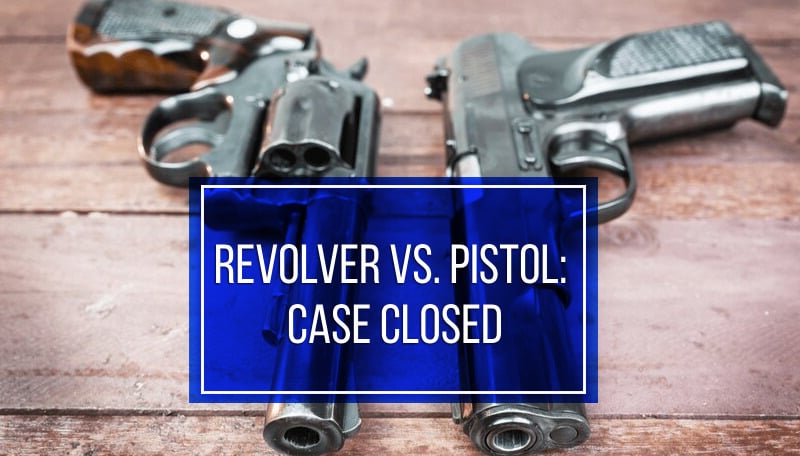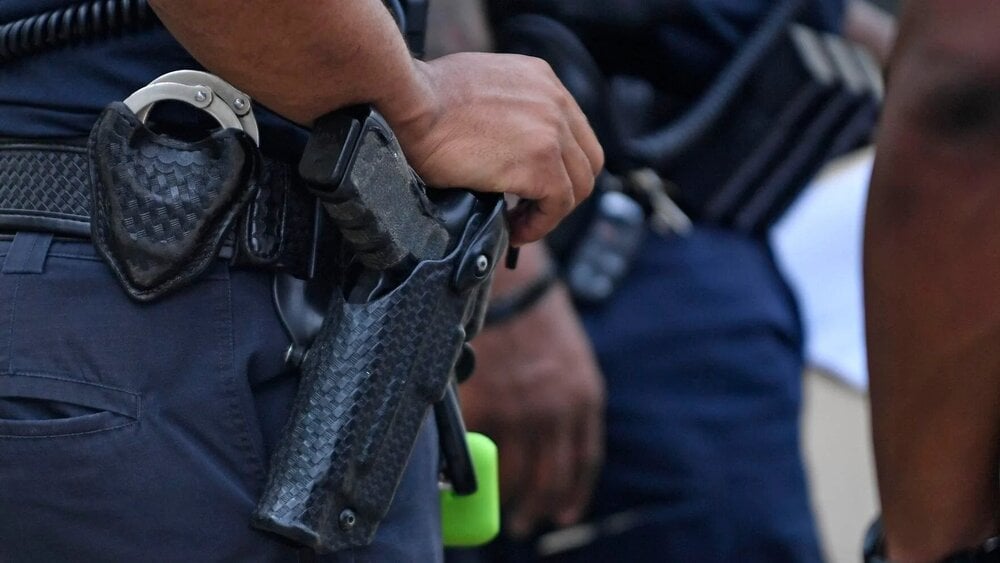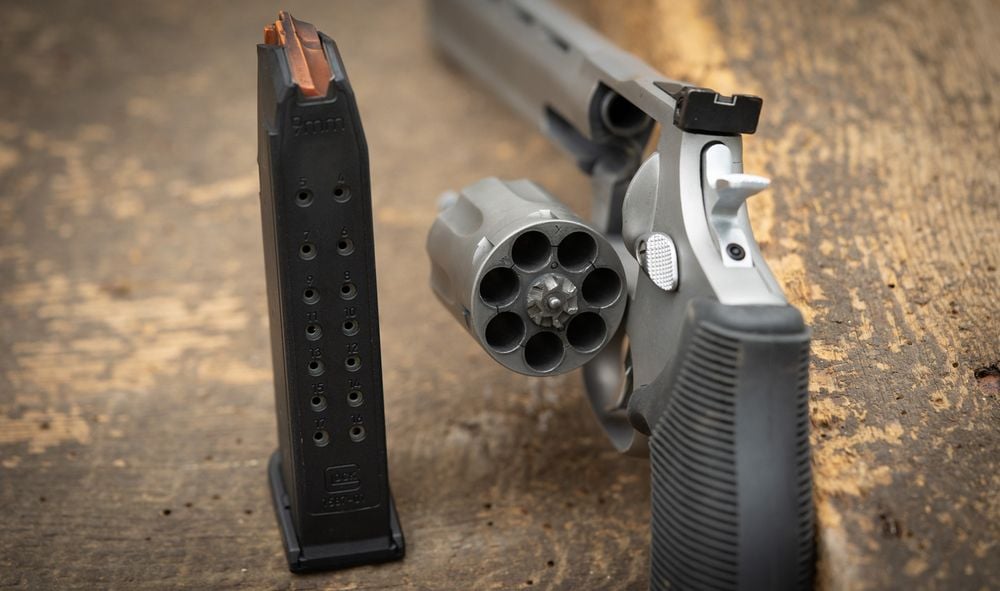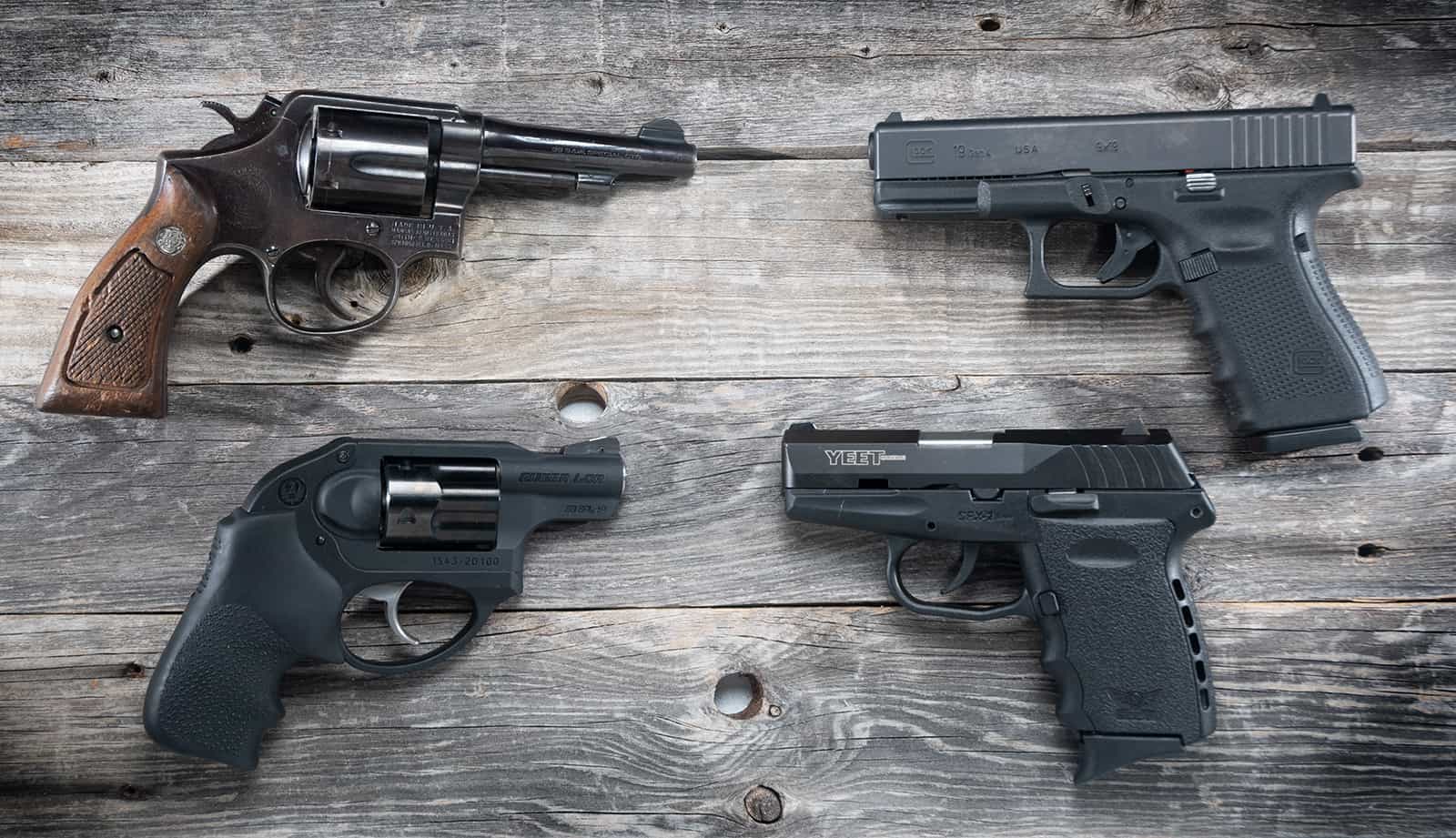
Last Updated on
The “revolver vs pistol” debate is as old as the guns themselves. It’s a perennial discussion that has sparked passionate debates among enthusiasts, law enforcement, and casual gun owners alike. Each side touts its favored firearm’s advantages, often downplaying the other’s merits. While some stand firm with the revolver’s reliability and simplicity, others praise the pistol for its capacity and modern design. But is one really superior to the other? The countless stories, favoring either of the contestants, has already been told. We’ll tell another one, simply because there’s no harm in knowing one more.
Table of Contents
Time Before Semi-Autos
Hollow Point Arrives
Advent of Semi-Auto Pistols
Revolver vs Pistol: Which is Better?
FAQs

The Time Before Semi-Autos
It is worth knowing that this debate, however old it might seem, didn’t begin until 1970s. The gun choices until those days were quite simple – uniformed police officers carried a 4” 6 shot .38 Special or .357 Magnum revolvers by Colt or Smith & Wesson. Those who carried concealed carried a 2” small frame .38 Special revolver by the same two makers. Ammo choice was even easier – 158 grain round nose lead in .38, 158g lead semi-wadcutters in .357 Magnum. The ”truth” of the day was that, while the military muddled along with semi-automatic .45’s and ball ammo, everyone else was kinda of biased towards semi-auto pistols. It wasn’t uncommon to hear people grumbling “Semi-automatics jam all the time!” and “Semi-automatics are inaccurate – hitting a washtub at 25 yards was an accident!” It’s not clear where this came from, but it was the accepted truth, and to suggest otherwise was heresy. A friend of mine, who worked for the U.S. Customs at the time, says he too carried 2” Smith & Wesson Chief’s Special Model 60, and 6 extra rounds in the aptly named “dump pouch.” According to him, it did dump, usually in the worse places at the worse times, like a donut shop filled with customers at 5AM, enroute to serve a search warrant (metaphor preserved).
Hollow Point Arrives
The discontent was disturbed when a man named Lee Juras shocked the ammo world with his Super Vel ammo with lighter, 110 grain bullets. And those were the very Hollow Points that today are the primary rounds for any self-defense scenarios. At the time, there were some concerns that the rounds were inhumane and violated the Hague Convention (which the U.S. had not signed, and only applies to use by the military). It was believed by some people that guns would wear out in days, if you fired so much as one box of that ammo through them. The steel frames would stretch, the cylinders would fall out, and if you shot someone, you would be in big trouble – you can guess it.
Well, as you know, none of that happened. In fact, the Treasury Department and Winchester developed the Q4070 load – the very first P+ load. The specs were for a 110 grain bullet at 1,000 feet per second, out of a 2” barrel! Over the years, the law enforcers made the upgrade to 2.5” Model 19 Smith & Wesson revolvers, still using the Q4070 load. Qualifications moved from slow, timed, and rapid fire at bullseye round targets to a PPC type course on human shaped targets, and the Q4070 developed a record of actually stopping outlaws trying to kill officers.
My friend acquired a 1911 or two (or five, as he says) along the way, and started to shoot them. As expected, they were not unreliable when lubed and fed good ammo, and even took handloads. They were accurate enough right out of the box, for defensive use, given you’ve changed the sights and had a trigger job done. Having been a Firearms Instructor, he started to agitate for permission to carry a semi-auto – a 1911, to be more precise.

Advent of Semi-Auto Pistols
The officer’s appreciation of the semi-automatics was coupled with some scientific evidence. It started with reports comparing results with semi-autos vs. revolvers, where the semi-autos always were easier to shoot, resulted in high qualification scores, and, with the new hollow point ammunition, were as effective per round as our JHP revolver rounds. The breakthrough came when the Illinois State Police issued Smith & Wesson M39 9mm pistols to all their officers. Their stats justified the change (even though everyone had to carry the pistol in a cross draw full flap holster on the left side – even those who were left handed).
Eventually, the voices were heard, and officers received permission to carry semi-autos. My friend recollects that the moment he found out they could carry semi-autos, he used his lunch hour to drive home, get his STAR PD .45 out of the safe, load it with some JHP .45 rounds, and go back to work for the phone call he was having. U.S. Customs eventually issued S&W M6906 9mm pistols, then allowed officers to carry personal pistols if they were double action for the first shot. In a while, they started issuing Glocks, mostly in 9mm.
Over his 27 year career, which included 9 years as the lead firearms instructor at his academy, my friend trained over 5,000 officers. About 20% with revolvers, the rest with semi-automatics. So, even after the semi-autos were introduced, some people decided to stick to time-tested revolvers.

Revolver vs Pistol: Which is Better?
Even though my line of work never perplexed me with this revolver vs. pistol issue, my friend has lived through the revolver era and transitioned his agency to semi-autos, thus having experienced both types. So, which is better for personal protection, a semi-auto or a revolver?
Some people will shout in an instant “This is settled science! Semi-autos now, semi-autos forever!”. Others will contradict “Revolvers are all you need, it was all we ever needed!” And you know what? Both groups would be right! And both wrong! As wrong as anyone who says “If you don’t carry a XXX (fill in makers name) your days are outnumbered!” Or those who say “If you carry anything less than a YYY caliber, you are as good as gunless!“
But here’s what my friend says, and he does have some relevant background, training, and experience.
When he carried a revolver, he never felt undergunned. Of course, those were different times. In the 1970’s, outlaws did not want to shoot it out with “Feds.” They believed that “resistance was futile,” and to get in a shootout with them was to almost certainly result in their death, or life in prison without parole. “Don’t shoot, T-man” was a common response from those who got arrested. (T-man was Treasury Man – it was a long time ago, as he explains)
Today, many seem to have no morals or ethics and are willing to shoot at any officer, including Federal Agents. Many have been shot before and expect to survive. Or they actually think that life is like a video game, where they can call a bullet back, or click on an icon and bring people back to life.
Plus, the problem has changed. Most of those who got arrested by my friend were, at most, a group of 4 or 5, easily enough to be handled by 2 or 3 officers. Illegal aliens were exceptions on two counts – friends of his in the Border Patrol arrested groups of up to 100, with just 1 backup officer. But those aliens were not drug or person smugglers, and they knew they would not be mistreated, and quickly returned to Mexico where they could try again (and again and again). They respected the Border Patrol Agents, and rarely resisted.

Today, we must realize the role of both domestic gangs and the potential for a terrorist incident with multiple outlaws. A few may have body armor, or my be ’drug enhanced’ to the point where they do not feel pain. In either case, more hits, even with today’s more effective ammo, may be required to solve the problem.
Of course, one possible solution to this revolver vs. pistol issue is to carry speed loaders and/or more than one revolver. I know one individual who carries, not one, not two, but three five shot revolvers on his person at all times – plus reload ammo. His reasoning is “one for his strong side, one for his weak side, and one that can be reached from either side”. Do you think he’s wrong? I don’t! He has accommodated his manner of dress and lifestyle to his choice. And he trains regularly.
Revolvers have more bulk than semi-autos, and they can be more difficult to conceal. But again, it’s a matter of how you choose to accommodate your choices, both in clothing and lifestyle. Don’t expect to conceal 2 revolvers on your person in a tee shirt and shorts – but I am sure there are some who can – and do.
I understand the appeal of revolvers, that’s why I have one and I enjoy shooting it immensely. But I also have a semi-auto pistol, for the usual reasons of ammunition capacity and lack of bulk. So I don’t feel the need to settle for one side of the revolver vs. pistol argument.
The truth is, none of it really matters. According to the interpersonal conflict management data, within the last 50 years there have been very few situations where a private individual needed to reload either a revolver or a semi-auto. Some chose to reload, but the issue was already decided. There is no denying that at some place, at some time, someone needed to reload, but the big numbers tell a different story. However, this does not mean you should not carry spare ammo.
Of course, Law Enforcement is a different matter. Officers are expected to run toward the sound of gunfire, not away from it. Since they intentionally confronted the evil-doers, many police officers simply have to reload.
Conclusion
The only thing that matters in choosing a handgun is: Which style is more efficient for you to make fast hits on target. It does not matter which I, or your instructor, your best friend, or some “gun guru” on the internet prefers. If you can make hits faster with a revolver, by all means, carry a revolver. If a semi-auto allows you to maximize your speed and accuracy (in that order), choose a semi-auto. No matter what your choice, get real training and practice. With all the noise about terrorist plots and mass murders, the reality is as follows: the odds of you ever getting into a shooting situation is small – never zero, but small; the odds of you being present at a terrorist attack or mass murder are even smaller – but still never zero. So, carry what YOU like, but train and practice – and will be ready when that day comes. The Revolver vs. Pistol case is closed.
FAQs
What is the main difference between a revolver and a pistol?
A revolver contains a revolving cylinder in which bullets are loaded, usually holding six shots. A pistol, on the other hand, does not contain its ammunition in a revolving cylinder and typically has a removable magazine into which bullets are loaded.
What are the advantages of a pistol over a revolver?
Pistols generally hold more rounds than revolvers and can be reloaded faster. This makes them a preferred choice for situations that require rapid firing and reloading.
Why would someone choose a revolver over a pistol?
Despite having a lower ammo capacity and slower reloading time, revolvers are praised for their ease of use when loaded and their less likelihood to jam due to user error.




Comments (1)
Lisa Craftonsays:
April 27, 2024 at 1:00 pmThere is one more difference that is noise. A semi makes click clock sound letting anybody within ear shot know exactly where you are. Hence making you an easier hit. A revolver , like mine with no hammer or stupid laser sight, is basically silent to pick up, always ready to shoot without telling anyone your location. This could save your life in many situations. Both are good for me silence is better.a matte finish is best. A bright flashlight & a dog are very good too.